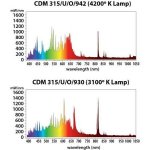Bulb size or diameter (maximum) is expressed in an eighth of an inch (1/8") for one unit. For instance, a BT56 bulb is 56 eighths of an inch in diameter, or 7 inches in diameter. See ANSI C79.1 for complete details on bulb shapes.
37/8=4.625 inches in diameter
best post in while, big thanx avenger
so then BT means bulb Tube?







